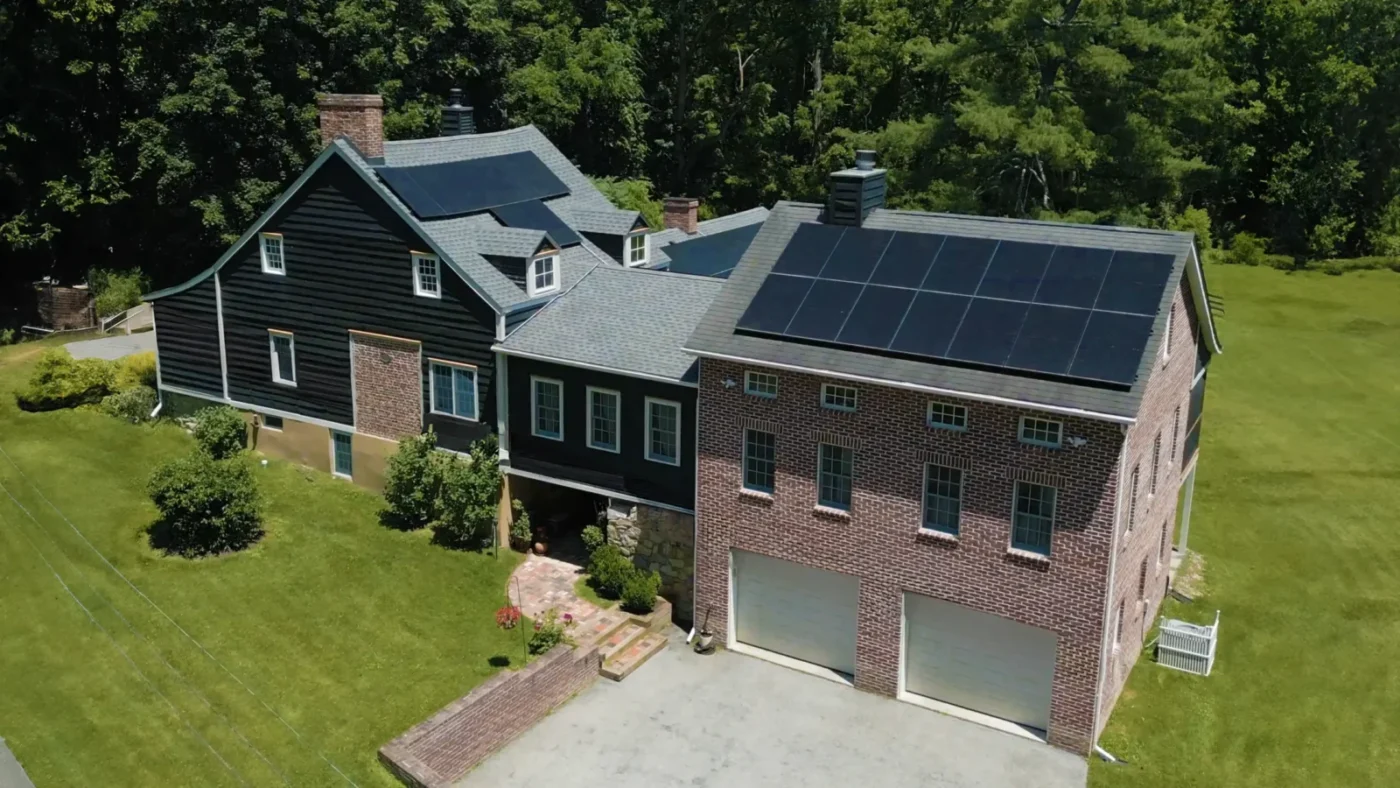Solar incentives are at an all-time high in 2025, and electricity rates keep climbing. As a result, solar power has become a hot topic for New York homeowners. But even with so much great information out there, many people still wonder: Is solar even worth it for me?
If you can confidently answer these 5 key questions, you’ll know whether or not it makes sense to reach out to a local solar company, or to explore other methods of making your home more energy efficient. In the sections below, we will dive into the 5 reasons that will either make or break your chances of benefiting from solar power.
Do You Get Enough Sun?
Before you even start thinking about the answer:
Yes, solar works in New York – even in winter.
Many people still think that we don’t get enough sun in New York to see significant savings with solar. But it’s simply not true. In fact, a south-facing New York roof can receive nearly 2,000 sun hours per year.
That’s enough to generate over 11,000kWh per year with a 8kW system. At an average rate of $.20/kWh in New York, that offsets over $2,200 in electricity costs annually.
Shading and Trees
Having trees on your property doesn’t necessarily mean that you can’t benefit from solar, but they could impact your system’s performance.
First, it’s important to identify whether or not a tree will even cast shade on your panels. If the tree is located to the north of your home, the tree won’t cast shade unless the limbs are hanging over the panels. It’s the trees to the south of your home that could block essential sunlight.
In many cases, strategic tree trimming or removal is a worthwhile tradeoff. When looking at this from an environmental perspective, it may seem counter intuitive to cut down trees to go solar. But over time the amount of pollution avoided by generating your own power greatly outweighs the downside of removing a few trees.
Hot Take: Solar panels still generate power on cloudy days and in the winter.
Many people are surprised to learn that solar panels produce energy on cloudy days and throughout the winter. In fact, most of our customers still overproduce energy in the early spring and early fall months.
Do You Have Enough Roof Space?
Common Obstructions & Space Requirements
Roof obstructions can vary from minor features like a vent pipe to larger obstacles like a chimney or dormer windows. While a single pipe tends to only eliminate space for a single panel, a large dormer window in the middle of a roof could greatly reduce usable area for solar panels.
How much space do I need?
Understanding the amount of roof space you’ll need is essential before moving forward with solar. A 460W solar panel measuring 68 inches by 47 inches translates to about 22 square feet per panel. For a 8kW system (the most common residential size) you’ll need around 410 square feet of clear roof space.
Next, you’ll need to check how much electricity you use to determine how much solar power you need to offset it entirely. Rather than guess, have a trusted solar professional accurately size your system based on your usage history, roof layout, and available local incentives.
Ground Mounted Solar
If your roof doesn’t have enough space, ground mounting can be a great option. The most important thing to consider is how much property you have. It’s generally best to have over 2 acres of property with most of that being open and free of trees.
Keep in mind that every town or city has its own set of rules and regulations for ground mounted solar installations. Some will not even allow ground mounted solar without additional paperwork and meeting with architectural review boards (but we’ll help you with it). Although we attend these meetings on your behalf, it’s best to understand your area’s unique requirements for ground mounted solar projects as they can significantly increase your installation timeline.
Is Your Electric Bill Over $100/Month?
Know Your Cost per kWh
In order to get a better understanding of your electricity costs and usage, take a look at your last 12 months of electricity bills. Add up each total bill amount and then divide that total by 12. Is the final figure higher than $100? If yes, then you will most likely see an up front savings with solar.
It’s also important to know what you’re paying per kWh. If your current rate per kWh is too low, you may not see any up front savings with solar until your power company increases their rates.
To determine what you pay per kWh, take your total electricity bill amount and divide it by the number of kWh you used in that billing cycle. Keep in mind that kWh rates can vary slightly from month to month but remain relatively constant throughout a single year. It’s always best to look at annual figures to get a better understanding of your true average cost per kWh.
To calculate your average kWh rate, all you need to do is add up your usage over a 12 month period. Most electricity companies will include a bar graph that shows your last 12 months of usage alongside your usage for the current billing period. Once you know your annual kWh usage you need to divide your annual electricity costs by your annual kWh usage to get your true average cost per kWh. If that number is below $.15/kWh then you may not see immediate savings with solar.
Quick Guide: If your average rate is above $0.15/kWh, solar will likely provide upfront savings.
Read More: Breaking Down Your Electric Bill: What Every New York Homeowner Needs to Know.
What Incentives Do You Qualify For?
Tax Credits Are Not Guaranteed
Most of the incentives available for homeowners are in the form of Federal and State Tax Credits. But, these credits are not guaranteed. You must have enough tax liability to claim these incentives. Homeowners who pay little to no income taxes, will receive little to no tax credits because you can only claim as much as you pay in taxes.
Example: A homeowner who paid $12,000 in Federal Income Taxes can only claim as much as $12,000 in tax credits. The same applies to State Income Taxes. If someone only pays $3,000 in State Income Taxes, they can’t claim a tax credit more than that amount.
If your tax liability is too low to use the full solar tax credit in one year, the unused portion can be rolled over to future tax years. Always consult with your tax advisor to see how long it would take to receive both the Federal and State tax credits. Anything over 3 years could greatly impact your short-term solar savings.
NYSERDA Rebates
On top of State and Federal Tax Credits, New York homeowners have access to up front rebates through NYSERDA. These incentives however can vary depending on zip code and even household income. Some areas of New York have already used their allocated NYSERDA incentives in their region. These rebates are first come-first serve and once a region has met full capacity, the rebate either drops or goes away entirely.
Qualifying for these rebates can provide even more financial relief for homeowners looking to make the switch to solar. This rebate can be as high as $20,000 depending on someone’s income and location. It’s best to work with a NYSERDA certified installer that knows the ins and outs of applying for this rebate as it can greatly reduce the overall project cost for New Yorkers.
For more information regarding all of the incentives available in New York, visit our blog article where we dive into each incentive in more detail.
Read More: Everything You Need to Know About New York’s Solar Incentives.
Will You Save Money Year One?
Most homeowners understand that installing solar can save you money in the long term, but most of our customers were shocked when they learned that you can save money as soon as the panels are turned on.
As long as your monthly solar payment is lower than your average electric bill, you will start saving money day one with solar. Any electricity your panels generate is pulling money away from what you would have to pay your electric company.
When the panels generate all of your power, you only have to pay basic connection charges to your power company. Plus, as your power company increases electricity rates, your solar payment stay the same, locking in and increasing your savings.
Final Thoughts
If you meet these requirements then solar might be one of the best investments you can make for your home. Even if you only meet 4 out of 5 of the requirements, it wouldn’t hurt to get a free personalized savings plan for your home and weigh the pros and cons yourself.
With incentives starting to get phased down and eliminated, there has never been a better time to look into getting solar panels installed at your home. If you’re ready to see exactly how many panels you need and what kind of incentives you have access to, book a call with one of our Energy Advisors. We’ll work with you to design a personalized savings plan fit for you and your energy needs.


